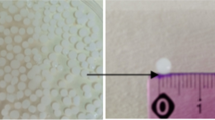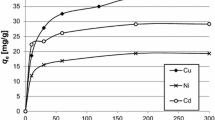Abstract
This paper discusses the possible application to use free and immobilized Cunninghamella elegans for the removal of cobalt from aqueous waste solutions. Results indicated that the maximum uptake occurred at; pH 4.0–5.5 ± 0.2, temperature range between 15 and 50°C and stirring rate 250 rpm. The uptake increased with the increase of metal ion concentration up to 40 ppm. Also, it was found that the best biomass weights used for biosorption were 0.25 and 0.5 g for both free and immobilized biomass. The reuse of control alginate beads, alive and dead immobilized Cunninghamella elegans beads was investigated for five cycles. Results showed that the percent uptake decreased slightly after the first cycle. While, in the case of alginate beads there was increase in the second cycle then returned to the same level of uptake. The uptake of cobalt in the presence of Cr(VI) and Cd(II) at different mixture concentrations 40, 50 and 60 ppm was investigated. The results showed that the uptake amount of Co(II) in the presence of other metal ions was lower than Co(II) alone except for Ca-alginate beads. SEM studies for control alginate beads, alive and dead immobilized Cunninghamella elegans beads were conducted to investigate the beads before and after the accumulation of cobalt ions.





Similar content being viewed by others
References
Abdel-Hameed MS (2006) Continuous removal and recovery of lead by alginate beads, free and alginate-immobilized Chlorella vulgaris. African J Biotechnol 5(19):1819–1823
Ahuja P, Gupta R, Saxena RK (1999) Sorption and desorption of cobalt by Oscillatoria anguistissima. Curr Microbiol 39:49–52
Aksu Z, Acikel U, Kustal T (1992) The biosorption of copper (II) by Chlorella vulgaris. Environ Technol 13:579–586
Arica MY, Kacar Y, Genc O (2001) Entrapment of white-rot fungus Trametes versicolar in Ca-alginate beads: preparation and biosorption kinetic analysis for cadmium removal from an aqueous solution. Biores Technol 80:121–129
Baldrian P (2003) Interaction of heavy metals with white-rot fungi. Enz Microb Technol 32:78–91
Baytak S, Turker AR (2004) Flame Atomic Absorption Spectrometric determination of manganese in alloys after preconcentration onto Amberlite XAD-4 loaded with Saccharomyces carlsbergensis. Turk J Chem 28:243–253
Domsch KH, Gams W, Anderson TH (1995) Compendium of soil fungi. Lubrecht & Cramer LTD, New York
Doshi H, Seth C, Ray A, Kothari IL (2008) Bioaccumulation of heavy metals by green algae. Curr Microbiol 56:246–255
Faisal M, Hasnain S (2004) Microbia conversion of Cr(VI) into Cr(III) in industrial effluent. African J Biotechnol 3(11):610–617
Ferraz AI, Teixera JA (1999) The use of flocculating brewer’s yeast for Cr(III) and Pb(II) removal from residual wastewater. Bioproc Eng 21:431–437
Fourest E, Roux C (1992) Heavy metal biosorption by fungal mycelia by-products: mechanisms and influence of pH. Appl Microbial Biotechnol 37:399–403
Friis N, Myers-Keith P (1986) Biosorption of uranium and lead by Streptomyces longwoodensis. Biotechnol Bioeng 28:21–28
Godlewska-Zyłkiewicz B (2004) Precocentration and separation procedures for spectrochemical determinations of platinum and palladium. Microchimica Acta 147:189–210
Horsfall MJ, Spiff AI (2005) Effects of temperature on the sorption of Pb2+ and Cd2+ from aqueous solution by caladium bicolor(wild cocoyam) biomass. Electron J Biotechnol 8(2):162–169
Igwe JC, Abia AA (2003) Maize Cob and Husk as adsorbents for removal of Cd, Pb and Zn ions from wastewaters. Physical Sci 2:83–94
Igwe JC, Abia AA (2005) Sorption kinetics and intraparticulate diffusivities of Cd, Pb and Zn ions on maize cob. Afr J Biotech 4(6):509–512
Ilhan S, Nourbakhsh MN, Kilicarslan S, Ozdag H (2004) Removal of chromium, lead and copper ions from industrial wastewaters by Staphylococcus saprophyticus. Turkish J Elect Biotechnol 2:50–57
Kuyucak N, Volesky B (1989) Accumulation of cobalt by marine algae. Biotechnol Bioeng 33:809–814
Lison D, Boeck D, Verougstraete M, Kirsch-Volders VM (2001) Update on the genotoxicity and carcinogenicity of cobalt compounds. Occup Environ Med 58:619–625
Mclean RJC, Campbell AM, Khu PT, Persaud AT, Bickerton LE, Beau CD (1994) Repeated use of Bacillus subtilis cell walls for copper binding. W J Microbiol Biotechnol 10:472–474
Moore TW (1994) Inorganic contaminants of surface wat. Residuals and monitoring priorities. Springer, New York
Pal A, Ghosh S, Paul AK (2005) Biosorption of cobalt by fungi from serpentine soil of Andaman. Biores Technol 97(10):1253–1258
Pitt JI (1979) The genus Penicillium and its teleomorphic states of Eupenicillium and Talaromyces. Academic press, London, p 643
Sag Y, Kustal T (1996) Fully competitive biosorption of chromium (VI) and iron (III) ions from binary metal mixture by R-arrhizus: use of the competitive Langmuir model Process. Biochem 31(6):573–585
Samson RA, Hoekstra ES, Frisvad JC (2000) Introduction to food- and airborne fungi. Butterworth Publishers, Boston, pp 425–445
Spinti M, Zhuang H, Trujillo EM (1995) Evaluation of immobilized biomass beads for removing of heavy metals from wastewaters. Wat Environ Res 67:943–954
Suhasini IP, Sriram G, Abolekar SR, Sureshkumar GK (1999) Biosorptive removal and recovery of cobalt from aqueous systems. Proc Biochem 34:239–247
Tobin JM, White C, Gadd GM (1994) Metal accumulation by fungi: applications in environmental biotechnology. J Ind Microbiol 13:126–130
Tripathi P, Srivastava S (2007) Mechanism to cobat cobalt toxicity in cobalt resistant mutants of Aspergillus nidulans. Indian J Microbial 47:336–344
Valdman E, Erijman L, Pessoa FLP, Leite SGF (2001) Continuous biosorption of Cu(II) and Zn(II) by immobilized waste biomass sargassum sp. Proc Biochem 36:869–873
Acknowledgments
The authors wish to thank the Director of the Academy of Scientific Research & Technology of Egypt for providing the M.Sc. fellowship to the student M.S. Mahmoud, and the Head of Hot Lab Center for the financial assistance. Thanks also extended to the Director and Staff of the Regional Center for Mycology and Biotechnology—Al-Azhar University.
Conflict interest
The financial supply for this research was provide by the Hot Lab and Waste Management facility—Atomic Energy Authority of Egypt.
Author information
Authors and Affiliations
Corresponding author
Rights and permissions
About this article
Cite this article
Abdel-Razek, A.S., Abdel-Ghany, T.M., Mahmoud, S.A. et al. The use of free and immobilized Cunninghamella elegans for removing cobalt ions from aqueous waste solutions. World J Microbiol Biotechnol 25, 2137–2145 (2009). https://doi.org/10.1007/s11274-009-0118-z
Received:
Accepted:
Published:
Issue Date:
DOI: https://doi.org/10.1007/s11274-009-0118-z




